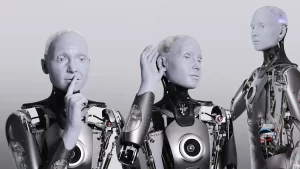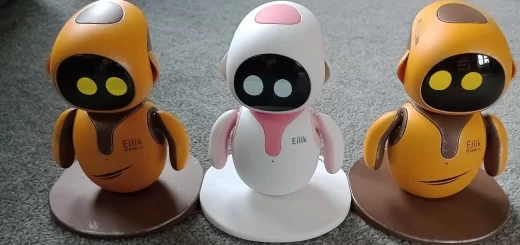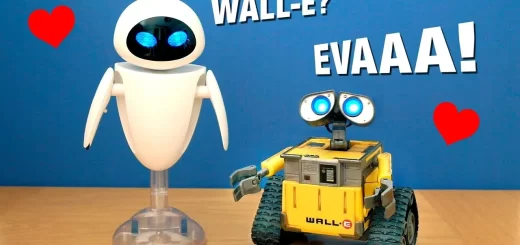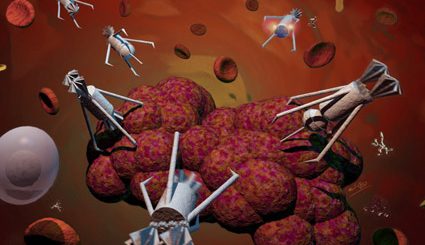Ameca features and Facial Expressions, Does Ameca have emotions and What is special about Ameca?
Ameca is designed to closely resemble a human, with a realistic face and body. The robot‘s face is made from a material that mimics human skin, allowing for subtle and complex facial expressions. It is a humanoid robot developed by Engineered Arts, It is known for its highly realistic facial expressions and advanced human-robot interaction capabilities.
Ameca
Ameca is known for its realistic human-like expressions and fluid movement, It is designed as a platform for the development of robotics technologies, particularly in the areas of human-robot interaction (HRI) and artificial intelligence (AI). The robot‘s appearance, which features a face capable of expressing a wide range of emotions, is strikingly lifelike, yet its body is futuristic, with a metallic, mechanical aesthetic.
Ameca review
Ameca robot represents a leap forward in human-robot interaction due to its advanced AI, lifelike movements, and expressive capabilities. While it’s not meant for physical labor, it excels in conversational and social roles, making it ideal for environments where human interaction is key, such as customer service, research labs, and public exhibitions. Its modularity and future-proof design also ensure that it will remain relevant as AI and robotics technology evolve.
Ameca can hold conversations and respond to human emotions, making it highly adaptable in social settings. It is one of the most advanced humanoid robots, developed by Engineered Arts, a UK-based company specializing in creating humanoid robots for research, entertainment, and educational purposes. Ameca has garnered significant attention for its lifelike movements, facial expressions, and ability to engage in natural conversations.
Ameca has an incredibly realistic design, especially in terms of its facial animations, It can simulate a wide range of human emotions, including happiness, surprise, and confusion, thanks to its advanced facial motors. The robot‘s head, neck, and hands move fluidly, mimicking human motion very well.
Ameca is powered by Artificial Intelligence, which allows it to interact with humans more naturally and engagingly. It can recognize and respond to speech, maintain eye contact, and follow conversations. The AI capabilities enable Ameca to understand and process human emotions, which enhances its ability to react appropriately during conversations.
The robot is designed to be modular, meaning parts of its body can be upgraded, replaced, or customized. This flexibility makes Ameca a long-term platform for testing and integrating new technologies. Its modularity also helps with maintenance and future-proofing the platform.
Ameca robot is equipped with speech recognition, natural language processing (NLP), and advanced sensors to detect people, movements, and objects around it. This enables it to engage in interactive dialogues, making it suitable for settings like customer service, exhibitions, and research demonstrations.
Ameca is designed specifically for engaging with humans. Its developers have emphasized that its main focus is on providing smooth human-robot interaction rather than heavy physical tasks, making it ideal for public interactions and research.
Due to its natural conversation skills and lifelike expressions, Ameca can serve as an interactive guide in museums, exhibitions, and customer service environments. Ameca’s sophisticated design and modularity make it a strong platform for AI and robotics research, especially in fields studying human-robot interaction.
Its flexible design allows developers and engineers to test new ideas, particularly those related to AI integration, social robotics, and advanced motion systems. Ameca’s facial expressions, speech, and ability to track human emotions set it apart from other robots. It feels natural in its interactions. The ability to swap out parts or add new features makes Ameca a versatile platform.
Features of Ameca
Ameca can display a wide range of emotions through its facial expressions, including happiness, surprise, sadness, and confusion. The robot’s facial movements are powered by a sophisticated system of motors and actuators.
Ameca can display complex facial expressions, making it appear more human-like than most other robots. It can smile, frown, and show surprise or curiosity, which aids in natural interactions.
Ameca is designed to interact with people in natural, conversational ways, using AI to respond to verbal and non-verbal cues. Ameca is intended as a research platform for AI, robotics, and other advanced technologies rather than being a commercial product for everyday use.
Ameca has a modular architecture which increases its flexibility for research and development. It is built with a modular design, meaning that different parts of Ameca can be upgraded or replaced independently. This makes it easier to maintain and improve over time.
Ameca made headlines due to its incredibly lifelike appearance and its potential for advancing human-robot collaboration and communication. It’s frequently used in demonstrations and exhibitions to showcase the future of humanoid robotics.
Ameca is equipped with advanced AI for natural language processing, enabling it to understand and respond to human speech. Ameca can engage in conversations, answer questions, and react to verbal cues.
In addition to facial expressions, Ameca can use body language to enhance communication. It can move its head, arms, and hands in ways that mimic human gestures.
Ameca is equipped with cameras and sensors that allow it to detect and respond to its environment. It can track objects and people, recognize faces, and interpret body language.
The robot’s responses are generated in real-time, allowing for fluid and natural interactions with humans. This is a step forward in creating robots that can effectively engage with people in social contexts.
Ameca emotions
Ameca can show happiness, It can smile and express joy through a combination of facial movements and vocal tones. It can maintain a neutral expression, which is often used as a baseline in conversations.
Ameca robot can be surprised, It can widen its eyes, raise its eyebrows, and open its mouth to convey surprise, It can answer questions, and react to verbal cues.
Ameca can be sad, It can express sadness by lowering its head, drooping its eyes, and frowning, Through subtle facial adjustments, the Ameca robot can convey confusion, often accompanied by head tilting and inquisitive expressions.
Ameca can show curiosity, It can display curiosity by raising its eyebrows, tilting its head, and maintaining eye contact, which mimics human behavior when they are intrigued or interested. Ameca can convey confusion through subtle facial adjustments, often accompanied by head tilting and inquisitive expressions.
Ameca represents a significant advancement in humanoid robotics, particularly in its ability to interact with humans in a lifelike manner. Its combination of advanced AI, realistic design, and expressive capabilities makes it a leading example of the future of human-robot interaction.
Ameca interview
Ameca, a humanoid robot developed by UK-based company Engineered Arts, has gained attention for its advanced conversational abilities and expressive facial features. During interviews, Ameca can engage in realistic dialogue, responding to questions naturally and with gestures that enhance the conversation. The emotional expressions Ameca displays, while appearing authentic, are programmed responses and not genuine feelings. These expressions are created using advanced AI and robotics to simulate human-like emotions.
Engineered Arts designed Ameca with a highly flexible face that can move in a range of realistic ways, allowing for expressions like smiling, frowning, surprise and nuanced gestures like eyebrow raises. Although Ameca’s responses and expressions are impressive, they are driven by algorithms that analyze verbal and contextual cues to determine an appropriate facial response, giving the impression of empathy or understanding.
In interviews, Ameca often talks about its lack of actual consciousness or emotions, explaining that her facial expressions are meant to enhance user interactions rather than indicate real feelings. This transparency is part of what makes her interviews intriguing; Ameca “understands” enough to convey that It doesn’t understand emotions in a human sense but can still simulate them effectively.
Ameca‘s conversational AI relies on natural language processing (NLP) and machine learning models to interpret questions and provide real-time answers, enabling dynamic interaction. This has made her popular in demonstrations and conferences, where it showcases the potential of robotics to engage in human-like exchanges. However, Ameca’s interviews underscore a key distinction: its lifelike responses are tools to improve human-robot interaction, not reflections of self-awareness or genuine emotion.
Drawbacks of Ameca
While Ameca looks robotic with its exposed metallic components, its overall design is futuristic and appealing. It’s not fully humanlike but sits in a “sweet spot” of being approachable without entering the uncanny valley. Due to its advanced nature, it is expensive, limiting its availability to research institutes and businesses rather than personal use.
Although Ameca can interact smoothly, it cannot walk or move autonomously. Its focus is on stationary interaction. Ameca isn’t designed for physically intensive tasks like other robots (e.g., Boston Dynamics’ Atlas). It’s mainly meant for conversational and expressive purposes.
You can follow Science Online on YouTube from this link: Science online
Ameca robot review, features, advantages, disadvantages and what can Ameca do?
Humanoid robots use, types, risks, advantages and disadvantages
Sophia robot review, features, use, advantages and disadvantages
Robot teachers use, types, advantages, and disadvantages
Tesla robots (Optimus) review, use, advantages and disadvantages
Eilik Desktop Companion Robot structure, features, use, advantages and disadvantages




